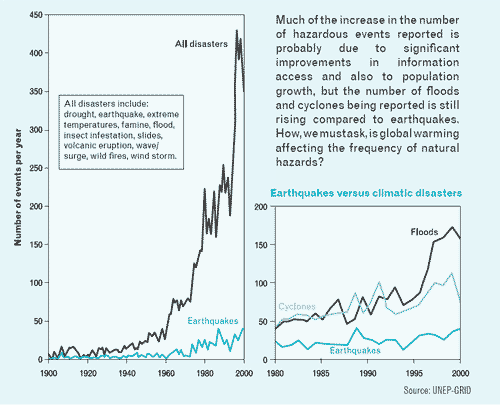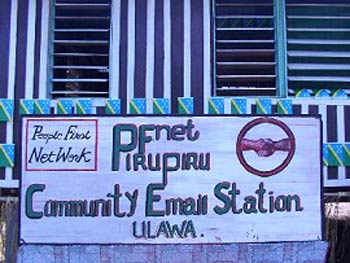 |
Tom Roper considers action that energy utilities can take in vulnerable Pacific island countries. |
| The author is a board member of the Climate Institute. | |
The world's 51 Small Island Developing States (SIDS) and Territories are amongst the most vulnerable to the impacts of climate change despite the fact that they contribute almost nothing to the growth of global greenhouse emissions - less than 0.02 per cent.
They are characterized by small populations, limited resources, lack of economies of scale and financial and technical resources, remoteness, a susceptibility to natural disasters and are highly dependent on and vulnerable to international trade. The pressures of climate change, particularly sea-level rise and extreme weather events, add to often already stressed social and environmental conditions.
In this article, I'll be examining the most recent climate change assessments, probing SIDS' vulnerability, explaining why electric utilities matter, suggesting new energy investment possibilities and urging immediate action.
At last the public argument about whether climate change is real or fiction has been resolved. Climate change is a threat to humankind's future. Al Gore's movie, Nicholas Stern's review, the latest Intergovernmental Panel on Climate Change (IPCC) report and Hurricane Katrina have all moved the debate to the conclusion that urgent action is overdue and must be taken immediately.
In February 2007, the IPCC Chair, Rajendra Pachauri, said: "Warming of the climate system is unequivocal, as is now evident from observations of increases in global average air and ocean temperatures, widespread melting of snow and ice, and rising global mean sea level."
The IPCC Working Group III found climate change "to be irreversible over human time scales, and much of the damage... likely to be irreversible even over longer time scales" (Chapter 1, page 9). Carbon dioxide concentrations have increased by more than a third since the 19th century and will continue to grow. Growth rates have actually increased significantly over the past decade. By 2100, temperature rises could be as high as six degrees Celsius.
Harvard University's Professor of Environmental Policy, John Holdren, says that "the United Nation's goal of avoiding dangerous human interference is already out of reach," that the "current level of interference is dangerous," and that "the issue is whether catastrophic interference is avoidable."
Potential impacts are increased temperatures, sea-level rise, extreme events and changes in precipitation. These impacts directly affect many sectors:
- health - infectious and respiratory diseases and heat stress;
- agriculture - lower crop yields and irrigation demands;
- forest - composition, health and productivity;
- water resources - supply and quality;
- coasts - inundation, erosion, loss of coral and mangroves; and,
- species and natural areas - loss of habitat and species.
Rachel Warren, from the Tyndall Centre in the United Kingdom, highlights an 80 per cent loss of coral reefs with a one degree Celsius rise. Coral reefs and mangroves provide coastal defenses, encourage fishing and promote tourism. Coral is under threat with higher water temperatures, and in July 2006 the United Nations Environment Programme reported that over half of the Pacific mangroves could be steadily lost.
Estimates of sea-level rise have varied over time and between computer models. The recent IPCC report, for example, suggested a rise of up to 50cm as a result of thermal expansion and melting glaciers. Stefan Rahmstorf of Potsdam University in Germany suggests a metre this century. Standing on a Marshall Islands atoll, a metre rise would see almost total immersion.
Speaking at a United Nations Framework Convention on Climate Change meeting in February 2007 in Jamaica, Graham Sem of Sustainable Environmental Management Ltd in Auckland, New Zealand, said that a 50cm rise would result in a loss of up to 60 per cent of beaches in some areas. Most economic and social activity in small islands is within two metres of sea level and more than half the population of Small Island States live within 1.5kms of the shore.
In July 2007, Vaitoto Tupa, head of the Cook Islands National Environment Service, wrote in Tiempo that sea-level rise "could be devastating for the Cook Islands as all our population is dependent on the coastal areas in one way or another."
The results for SIDS, according to the IPCC Summary for Policy Makers (2Mb download), are:
- deterioration in coastal conditions through erosion of beaches and coral bleaching which will affect local resources;
- exacerbation of inundation, storm surge, erosion and other coastal hazards, threatening vital infrastructure, settlements and livelihoods;
- by mid century, water resources reduced to where they are insufficient to meet demand during low rainfall periods; and,
- with higher temperatures, increased invasion by non-native species and diseases.
Storm and flood numbers doubled over the 20 years to 2000 (see figure below). The Red Cross estimates that more than 200 million people are affected annually. The cost of extreme weather events in the Pacific in the 1990s exceeded US$2 billion. Cyclones accounted for 76 per cent of reported disasters between 1950 and 2004, followed by earthquakes, droughts and floods. According to a World Bank finding in 2006, cyclones cost an average of US$75.7 million per cyclone at 2004 values. Damage in some cases has exceeded the national Gross Domestic Product of countries such as Samoa in 1990/1 and Niue in 2004. In April 2004, Cyclone Sudal destroyed or damaged 90 per cent of homes in Yap.
 |
| Trends in natural disasters |
Global warming may not result in more cyclones, but it is likely that they will become more powerful (perhaps by 10 per cent), produce greater rainfall (20 per cent more), higher storm surges and greater human and infrastructure damage. Their power is influenced by warmer water, and storm strength could increase by half a category. For instance a mid category 4 storm would become category 5 - from wind speeds of 229 to 253 kilometres per hour.
Storm surges present an often greater threat with waves in recent cyclones 12 metres higher than normal levels. Model-based studies suggest that, by the year 2080, the number of people flooded by these "super storm surges" will be more than five times higher than present. The islands of the Caribbean and the Indian and Pacific Oceans face the largest relative increase in flood risk, with the number of people at risk being some 200 times higher than in most other parts of the world.
The Tuvalan people are already discussing resettlement and refugee status. Papua New Guinea's Carteret islanders are the first direct climate change refugees with islands inundated and damaged, gardens and water supplies destroyed by salt water intrusion and evacuation announced in 2005 (video report).
Can the Small Island States be defended? Island people and communities have been resilient in the face of disasters but that capacity is now being undermined. National plans for the inevitable threats include the "soft" measures of conserving natural sea defenses, such as the mangrove, and the "hard" approach of moving and strengthening infrastructure.
Espen Ronneburg of the South Pacific Regional Environment Programme points out that the "costs of overall infrastructure and settlement protection is a significant portion of Gross Domestic Product well beyond the means of SIDS." In 2004, a World Bank report concluded that Kiribati's Tarawa Atoll could face annual climate change damages between US$8 and US$16 million, from a Gross Domestic Product of US$50 million. Periodic storm surges could inundate 55 to 80 per cent of the land in North Tarawa.
One of the first actions, even if symbolic, in response to the climate threat is for Small Island States to reduce their own emissions, tiny though they are, to set an international example.
Energy utilities are major players in island economies, enabling industry development, improved lifestyles and a higher standard of living. A badly run or ill-prepared utility damages the economy, destroys opportunities and penalizes the less well off. Utilities must be a key element in national development and climate change plans and promote energy efficiency and renewable energy technologies.
As Tuiloma Neroni Slade, former chairman of the Alliance of Small Island States (AOSIS) and Ambassador of Samoa to the United Nations, said: "The Small Island States can by promoting a clean energy environment set an example for the rest of the world. Too much of our national budgets are spent on fossil fuels for diesel generation of electricity. This is a drain on our national budgets and does not work towards a solution to the problems of climate change. When the tanker comes in the foreign reserves go out."
The starting point is to look at everything utilities do. For many utilities, the losses from generation and transmission are an unacceptable 20 per cent or more. If they were halved the diesel requirement would drop by one gallon or litre in ten. Prices have gone up by more than 250 per cent since 2001, with fuel imports taking up more than half the value of exports. These are countries working hard just to meet the fuel bill. We urgently need to bench mark performance and document and adopt best practice.
The fuel used can also change. UNELCO, power supplier in Vanuatu, has experimented successfully with local coconut oil for one of its generators. New capacity will be specifically adapted for coconut oil and a target of 30 per cent set for 2010 - a real balance of payments boost.
 |
Renewable energy can also play its part. Clean non-greenhouse producing power sources include photovoltaics, solar hot water, wind turbines and hydro. Although, unfortunately, we still do not have enough examples, they are increasing. For example, a grid-connected solar array in Tuvaluhas been provided by the company E8 and cyclone-resistant wind turbines have been installed in New Caledonia.
The Solomon's is a leader, particularly at the village level, with solar-powered Australia and New Zealand Bank automated teller machines (ATMs). Community email stations, schools and resorts are also relying on the sun.
Equally important is working with customers to reduce their power use. At a cost of 25 US cents per kWh or more, energy efficiency can assist customers by reducing their bills and the utility by decreasing fuel use.
 |
The Marshalls Energy Company is installing 10,000 energy-efficient compact fluorescent lamps, arranged by the Climate Institute and provided by Climate Care.
Improved utility performance should be combined with working with customers to reduce their consumption. This is most vital in the poorest countries where unnecessary power plant investments to run inefficient equipment divert scarce capital from basic needs such as access to electricity and clean water. Appliances are also far more likely to be wasteful.
Key features of such "demand side management" programmes include compact and high-efficiency fluorescent lighting, refrigerator and air conditioner labeling and standards, commercial refrigeration and air conditioner equipment maintenance, energy audits, street lighting, solar hot water and interruptible and time of use tariffs.
|
Aspirational targets Pacific island governments might consider the following goals:
|
To be in a position to take up these opportunities, Pacific nations must get a fair share of aid, loans and technical assistance. The World Bank, in 2005, admitted that Pacific member countries receive less than a quarter of that provided in the Caribbean. Aid distribution from all donors has concentrated on the social sectors with only five per cent going to energy and this mostly from Japan. This is surprising given that 70 per cent of Pacific islanders don't have access to electricity.
A partial remedy is the recently announced World Bank, International Finance Corporation and Australia and New Zealand Bank's Sustainable Energy Finance Project. The project has the potential to bring cheap reliable electricity so that Pacific Islanders can have light at night, listen to the radio, run a small refrigerator and, at the same time, use power sources that are environmentally-sound and sustainable. It is being implemented in Papua New Guinea, the Solomon islands, Vanuatu, Fiji and the Marshall islands - but this leaves out a lot of Pacific islands.
The Pacific nations face huge challenges and threats from climate change. At the same time as tackling these problems, they can improve their own communities. However, the real work of first slowing, then stopping, global warming has to be done by the big emitters, led by the developed countries which have been pouring carbon dioxide into our atmosphere for 150 years. We can't stop the extra heat, sea-level rise and weather extremes that are already in the pipeline and will get much worse over the next 50 years. But we must make a start.
Former French President Jacques Chirac made it crystal clear: "Soon will come the day when climate change escapes all control. We are on the verge of the irreversible. Faced with this emergency, the time is not for half-measures. The time is for revolution: a revolution of our awareness, a revolution of the economy, a revolution of political action. We are the last generation that can save our planet."
Acknowledgements
This commentary is based on an article published in Pacific Power Magazine (volume 15, number 3, 2007), the journal of the Pacific Power Association.
Further information
Tom Roper, 702/320 St Kilda Rd, Southbank, Victoria 3006, Australia. Fax: +61-3-96966439. Email: tom.roper@bigpond.com.
On the Web
Tom Roper expands on the energy issues discussed in this article in The Cheapest Kilowatt: The Lessons of Energy Efficiency (0.3Mb download). The Tiempo Climate Cyberlibrary lists relevant websites on Small Island States and alternative energy.